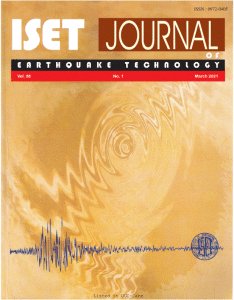Home > Issues & Journals
MODE ACCELERATION APPROACH FOR GENERATION OF FLOOR SPECTRA INCLUDING SOIL-STRUCTURE INTERACTION
Samit Ray Chaudhuri and Vinay K. Gupta
Paper No.: 434
|
Vol.: 40
|
No.: 2-4
|
December, 2003
|
pp. 99-115

Abstract
A mode acceleration formulation is presented for the transfer function of absolute acceleration response of a single-degree-of-freedom oscillator which is supported on a base-excited, classically damped and flexible-base primary system. The primary system response has been described in terms of fixed-base primary mode shapes, with the response in last few modes assumed to be pseudo-static. Base flexibility has been assumed to be described by complex-valued impedance functions, and the effects of kinematic interaction have been assumed to be negligible. The proposed formulation can be used within the framework of any power spectral density function-based random vibration approach to generate floor response spectra of desired level of confidence. A numerical study is carried out with the help of an example primary system and band-limited white noise to illustrate the proposed formulation. It has been shown that the proposed formulation gives very accurate estimates of floor response spectra if pseudostatic response is assumed to be in those primary modes only which are stiff enough to the base excitation. It has also been shown that neglecting soil-structure interaction may give too overconservative or unconservative estimates, depending on the damping ratio, natural period, and location of the oscillator, energy distribution in the excitation process, and shear wave velocity of soil.
Keywords: PSDF-Based Seismic Response, Floor Response Spectra, Mode Acceleration Approach, Soil-Structure Interaction
©2025. ISET. All Rights Reserved.